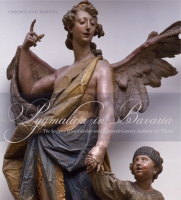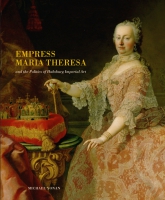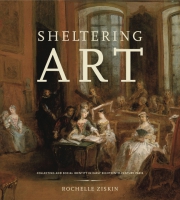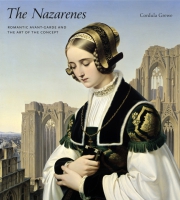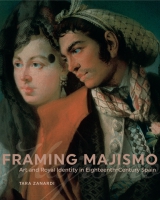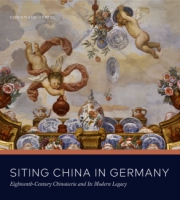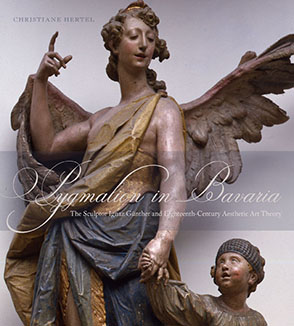
Pygmalion in Bavaria
The Sculptor Ignaz Günther and Eighteenth-Century Aesthetic Art Theory
Christiane Hertel
Pygmalion in Bavaria
The Sculptor Ignaz Günther and Eighteenth-Century Aesthetic Art Theory
Christiane Hertel
“This is an extraordinary book. Extraordinary is Hertel's command of eighteenth-century aesthetic art theory, extraordinary her command of Bavarian Rococo art, especially the art of Ignaz Günther, and extraordinary the depth of her understanding of the religious culture of eighteenth-century Bavaria. Pygmalion in Bavaria may seem to be a book for a small number of specialists. But the spell of Ignaz Günther's art should ensure that this unusually engaging text will find the readers that it deserves and will help secure, in the English-speaking world, Günther's place among the major artists of the eighteenth century.”
- Description
- Reviews
- Bio
- Table of Contents
- Sample Chapters
- Subjects
“This is an extraordinary book. Extraordinary is Hertel's command of eighteenth-century aesthetic art theory, extraordinary her command of Bavarian Rococo art, especially the art of Ignaz Günther, and extraordinary the depth of her understanding of the religious culture of eighteenth-century Bavaria. Pygmalion in Bavaria may seem to be a book for a small number of specialists. But the spell of Ignaz Günther's art should ensure that this unusually engaging text will find the readers that it deserves and will help secure, in the English-speaking world, Günther's place among the major artists of the eighteenth century.”
“Now at last Christiane Hertel, professor at Bryn Mawr, will introduce Günther in English to future generations with a thoughtful book that goes well beyond the conventional monograph to probe the Bavarian Rococo, for example as a religious combination of the visionary with a personally subjective totality, ‘commemorative in a quasi-Lutheran sense.’ Such piety distances Ignaz Günther from modern taste, so here Hertel fills a real need to reconstitute his aesthetic ambitions, while subtly suggesting that his works may lie open to theological questioning in their own era.”
Christiane Hertel is Professor of Art History at Bryn Mawr College.
Contents
List of Illustrations
Acknowledgments
Introduction
1. Ignaz Günther (1725–1775)
2. Pygmalion in Bavaria
3. Sculpture and Religious Culture in Counter-Reformation Bavaria
4. Unruly Art: Günther’s Angels and Their Behavior in Church
5. Günther’s Kerkerheiland and Rebellious Humility
6. Günther in Weyarn and the Liberties of Procession Sculpture
7. “Broken Unity”: Günther’s Self-Reflective Viewers
8. Pygmalion Intention, Pygmalion Reverie
Notes
Bibliography
Index
Introduction
The true feeling for beauty resembles plaster that has been poured over the head of Apollo and touches and envelops him entirely.
—Johann Joachim Winckelmann, “On the Ability to Sense Beauty in Art” (1763)
Wonder mixed with awe will transport you beyond yourself, like Pygmalion, under whose hands his image assumed life and movement: yes, the corporeal will become spiritual.
—Johann Joachim Winckelmann, second draft for the “Description of Apollo” (early 1760s)
I forget everything in view of this miracle of art and I myself assume an elevated pose in order to perceive it with dignity. My chest feels widened and elevated in veneration, like his, which I see imbued with the spirit of prophesy, and I feel myself transported to Delos and the Lycan groves, places which Apollo honored with his presence: because my image seems to assume life and movement like Pygmalion’s beauty.
—Johann Joachim Winckelmann, final version, History of Ancient Art (1764)
In his accounts of the Apollo Belvedere cited here, Johann Joachim Winckelmann refers to Pygmalion to convey the experiences of spiritual transcendence and historical transport, one bound to—rather than contradicting—the other and each stimulated by sculptural beauty and creative imagination. In these Pygmalion responses to the Apollo, sculptor and viewer share a creative impulse and agency. Yet it seems that Winckelmann not only feels like Pygmalion the artist, he also feels like Apollo the prophet. Past, present, and future become one, and this moment of transcendence and power is a blissful suspense of time and place. He mentions veneration and announces that the corporeal becomes spiritual. Furthermore, the imaginary touching of the sculpture appears comparable to the effect of a miraculous image, and, indeed, the sculpture is called a miracle of art. Accordingly, the viewer, as believer, in his soul re-creates and imitates the venerated being, Apollo, and this difference between physical creation and mental or spiritual re-creation as imitation is stressed by what now may seem the infelicitously constricting metaphor of the poured plaster cast: The feeling for beauty thus imitates and enshrines the miracle of art. While the eighteenth-century discourse about the myth of Pygmalion primarily regards art, nature, and the power of human creativity and rationality, some sources also deal with its miraculous and latent religious aspects and the limits of human power. This dialectic, apparently seen as an embarrassment already back then, has not been explored in studies of eighteenth-century sculpture and aesthetics. In Winckelmann this dialectic seems to be ascribed to both his Neoplatonic leanings and his homoeroticism, whereas his conversion to Roman Catholicism, on the one hand, and his early training in theology, on the other, have tended to be seen solely as career moves: Theology was the only way up, and conversion the only way to Rome. Still, a tension obtains between biographical facts and intellectual aspirations. The myth of Pygmalion represented this for Winckelmann, whose choice of “you” rather than “I” in one of the passages cited here claims an existential commonality, if not universality, of experience, or at least the potential for it.
I contend that the myth of Pygmalion functioned in this way also for others, such as the sculptor Ignaz Günther (1725–1775). In the present study I show that in Günther’s art this works itself out as a perceptible self-awareness based in reflections on the Protestant critique of idolatry, on sculpture’s ritual functions in Catholic religious culture, and on the spiritual meaning accorded to sculpture in eighteenth-century German aesthetics. Thus I propose to apply a genre of writing alternating between celebratory individual attention to mostly single-figure sculptures (with the exception of the Laocoön Group) and generalizations about art’s freedom among the Greeks to a multimedia art resulting from such complex collaboration that not only today but perhaps already back then the creation of sculpture for a Rococo church interior was nearly unimaginable to others, leading them to assume strong institutional authority. The methodological challenge of seeing and understanding the relationships between the two concepts of artistic creativity lies in overcoming an unnecessary, biased distinction between the presumably free creative individual and the presumably opaque group identity bending to institutional authority.
Thinking beyond such a divide dates back to the late eighteenth century itself. Goethe, in his 1798 essay on “arabesques,” a term then widely used for the latest fashion of neogrotesque interior decorations based on Roman wall paintings in Herculaneum and Pompeii, suggests that the modern, individual artist is capable of such collaboration only as an equal among equals within a democratic work structure and on the basis of a shared taste: “If at all, should such a thing be undertaken again, then only a rich association of talents guided by a unifying taste could succeed felicitously in this. They would have to be willing to subordinate themselves to one another so that everyone could take his place in a spirited [geistvoll] way.” In the early and mid-eighteenth century, such collaboration was worked out by way of competency stipulations for the guilds of sculptors, architects, and stucco artists, and contracts mediated by a Handwerksgericht (trades court), aligning and occasionally also suspending these rules for an artist like Johann Michael Feichtmayr (1709 or 1710–1772), who made both ornamental and figural, freestanding stucco sculptures, as opposed to ornamental decorations attached to walls and ceilings. If anything, the mobility between individual and group identity enables, rather than hinders, the discussion of sculptors working primarily either in stucco or in wood, as Ignaz Günther and Johann Baptist Straub did, in the context of eighteenth-century aesthetics and art theory, since both these artists always collaborated with others and yet obtained for themselves the privilege of working outside guild regulations.
While included with one or two examples in standard surveys, Günther is virtually unknown to the English-speaking audience for eighteenth-century studies. This is probably so for two reasons: much of his oeuvre deals with religious subjects, and almost his entire oeuvre is in situ in Bavarian Rococo churches or in Wittelsbach palaces and parks in and near Munich. Only a few works are in American and British museums. Another, more complicated reason may be their material. The sculptures are made of wood, rather than marble, and represent slightly under-life-size human figures as divinities, more or less saintly humans, angels, and ornament. Most of these appear in “Rococo white,” that is, in polished, porcelain-like plaster thinly modeled upon the carved work, with accents in gold. Others—perhaps surprisingly, the works one might hesitatingly call autonomous, and perhaps coincidentally the most highly valued and psychologically complex among Günther’s sculptures—are polychrome in subdued pastel color schemes. And a few pieces show, to use a modernist phrase, “material truth,” namely, silver and gold or exposed wood and stone. However, the issue of material does not rest with a modern prejudice for so-called material truth and against materials that represent others or, from that viewpoint, pretend to be what they are not and so deceive an audience supposedly desiring material truth. Certainly this prejudice, derived from the art theory of Gottfried Semper in the nineteenth century and then modified in Bauhaus functionalism and often maintained in thought and practice in historic preservation today, remains powerful.
But there is yet something else invested in material, in marble or perhaps just in stone. It is the Pygmalion desire for life to be rendered in stone, and thus petrified, only then to be freed again from that petrifaction; the desire for there to be sculpture of human figures and then for it to come alive, by virtue of the beholder’s imagination, co-creativity with the artist, erotic fantasy. Apparently, this desire can believe in itself more easily or faithfully if a single material is endowed with the magic and potential of transformability, a material that is rather than shows. Put differently, the belief that somehow the seemingly sentient, responsive sculpture is more than human life, that it distills and instills a range of values associated with a free self more clearly or more purely than human life, presupposes a quality in sculpture in excess of all and any human life: the ability to transcend death. Undoubtedly this ability appears more evident in stone or rock. If in marble the distance from cold, hard, resistant matter to warm, pliable, and offered life is considered the farthest to travel, as was the predominant assumption in the eighteenth-century art-theoretical discourse and artistic paradigm of Pygmalion, then this distance, once mastered, appears to support the material’s inherent and seemingly miraculous potential. Accordingly, wood is never dead or alive enough, as it were, to fulfill the requirements for the dynamic model of stilled life revived; it remains all along too organic, too vulnerable, too mortal. Polychromy, moreover, further shrinks the distance from life to dead matter and back to life, in that it makes the sculpted figure resemble ordinary human life too much, makes it intrude in its audience’s lives too much and without the superior quality of a life already freed from death.
These concerns about sculpture, and even fears of it, infused eighteenth-century aesthetic art theory, which either entirely shunned or quickly dismissed contemporary polychrome sculpture, most of which was ecclesiastic. And that dismissal, which only superficially attaches to sociopolitical criticism of court and church, paradoxically and instructively entails the dismissal of the religious culture from which the faithful’s desire for the transcendence of death is borrowed in the first place, a borrowing thus denied. It is that dual dismissal, along with the turn to paradigms in Greco-Roman antiquity, that has led to the enduring concept of sculptural autonomy. Hegel already knew of this concept’s heavy burden when in his Lectures on Aesthetics he wrote about the phenomenal Göttertrauer, the melancholy sadness of classical sculpture seemingly aware of its own cultural loss and lostness. The considerations above give rise to several questions: How was it possible for polychrome ecclesiastical sculpture to function at all as religious art holding out or showing the promise of salvation? How did such sculpture navigate what should have seemed a much narrower terrain of possibilities in representing the transcendence of death? How could such art engage its audience in trusting it at all? And how, in the Age of Enlightenment, could artists entrust their creativity to it? Understanding the religious culture for which the works were made is crucial to any attempt at answering these questions. But equally important, these questions presuppose that sculptors were aware of the impulses coming to the fore in the Pygmalion paradigm. This, I think, was the case with several artists and is evident in their work, and perhaps most productively, variedly, and subtly so in the oeuvre of Ignaz Günther.
Ignaz Günther was arguably the most important sculptor in eighteenth-century Germany. His workshop was in Munich, where he enjoyed court privileges. His many commissions in the 1760s simultaneously connected him to remote monasteries and pilgrimage churches and to Munich’s Francophone court and urban culture. He apprenticed in Munich with the best-known and most successful Bavarian sculptor, Johann Baptist Straub (1704–1784), and briefly, albeit intensely, studied with Paul Egell (1691–1752) in Mannheim. Egell was a versatile sculptor working for court and church in both a Rococo idiom and an early classicist style, most evident in his Lycan Apollo. He had been a student of Balthasar Permoser’s (1651–1732), who, in turn, was a Bavarian Bernini student best known for the sculptural program and decoration of the Dresden Zwinger. In 1753 Günther also briefly, if successfully, studied at the art academy in Vienna and there encountered the early classicist sculpture of Georg Raphael Donner (1693–1749). In Vienna Günther excelled in his emulation of the model of classical antiquity and also as a student of architecture, winning first prize for his graduation piece, the lost group Aeneas Carrying His Father, Anchises, out of Troy. He returned to Munich and there established himself as one of the most sought-after sculptors of ecclesiastical art, an art defining itself within but also against the Asam brothers’ legacy of the theatrum sacrum. He also worked for the Wittelsbach court at the Schleissheim and Nymphenburg palaces. This brief summary offers one way of thinking about Günther’s becoming Günther; however, it is not the primary account I wish to offer in this book. While I hope to introduce the complexity of his works in relation to these schools of sculptural practice and style, my aim is to interpret Günther’s oeuvre in the context of eighteenth-century aesthetic art theory, that is, art theory primarily concerned with self-reflective perception and sensory experience. Both were in part based in the Protestant critique of idolatry, which implicitly challenged but also was challenged by sculpture’s ritual functions in the religious culture of late Counter-Reformation Catholicism.
From the early twentieth century onward, Günther scholarship, mainly monographic, has almost exclusively been published in German. His sculptures have rightly been called psychologically expressive in exceptionally subtle and suggestive ways. As will be seen, in this they often serve their purposes as commissions and just as often complicate them. An understanding of Günther’s sculptures, whatever subject they represent and functional task they fulfill, must also consider the nature and functions of sculpture in his day and the moral and aesthetic demands made upon sculpture by mainly Protestant writers. In each chapter I shall emphasize and interpret this aspect by drawing on passages from writings by Winckelmann, Herder, Goethe, Kant, and others, passages never or rarely used in this way, since their contempt of Rococo art and culture seems impermeable. I shall also cite and discuss the writings of Lorenz Westenrieder (1748–1829), the most prolific and versatile author and educator of the Bavarian Enlightenment, a nearly exact contemporary of Goethe and yet intellectually situated halfway between Günther’s and Goethe’s generations. Westenrieder’s voice cannot substitute for Günther’s verbal silence but may serve as a verbal complement to Günther’s silent sculptural eloquence. It is a critical voice alternately in agreement and in disagreement with the artist and as such must come after him. Moreover, Westenrieder’s belatedness, as it were, in the larger intellectual world of the German lands helpfully testifies to the fact that the problem of Pygmalion belonged to both the Rococo and the Enlightenment, especially in the middle third of the eighteenth century.
In demonstrating how Günther’s sculptures participate in different spheres, discourses, and spaces, my main purpose is not to usher the artist into the Enlightenment and thus into the narrative of modernism or even postmodernism. Instead, I am primarily interested in shedding light on an artist and an art not only neglected but actually avoided in studies of Rococo art in the context of Enlightenment thought, studies that prefer to think of Rococo art as the representation of a secular or secularized culture with geographic or demographic pockets of a primarily religious cultural life from a bygone era. In all this, throughout the book, I shall insist and demonstrate, as others have, that much insight is to be gained from interdisciplinarity and from thinking about Rococo, the Enlightenment, and the age of sensibility, or sentimentality, called in German the age of Sturm und Drang (Storm and Stress), as interconnected rather than as categorically separate. In taking this approach, I am not providing a comprehensive monograph on Ignaz Günther, something Peter Volk, Gerhard P. Woeckel, and Arno Schönberger have exemplarily achieved. Instead, by introducing and interpreting a selection of sculptures by Ignaz Günther, I hope to demonstrate that he is an artist worthy of the English-reading audience’s critical and aesthetic attention, the one inseparable from the other.
From early on, descriptions of Günther’s art in the scholarship note that his works simultaneously offer what they represent and take it back, with each of these modes seeming a physical property of the work and posing intellectual and emotional challenges for the viewer, then as now. The challenge throughout lies in the task, taken up in English-language scholarship by Kenneth Gross and Alex Potts, to engage theories of “the sculptural imagination,” to “remind ourselves of the speculative histories of sculpture one finds in such writers as Winckelmann, Hegel, or Rilke” that offer “shifting and often lapsed quests to realize previously unapprehended forms of life, repose, freedom, or consciousness,” but to do this in relation to sculpture that was not made in and for the secular, phenomenal world both Gross and Potts assume, but in and for late Counter-Reformation Bavaria.
Much, then, depends on one’s preconceptions about the Rococo. Hermann Bauer, for example, in his scholarly reexamination of rocaille as critical form, may well have crossed paths with Alain Resnais, who had just interpreted some of the same spaces and places in his film Last Year in Marienbad (1961). The myth of Pygmalion and the relentless presence of sculpture and ornament are crucial to this film, though as destructive, rather than constructive, forces, which in the end are left behind in a nocturnal escape. Nymphenburg’s Amalienburg and Schleissheim Palace’s main reception hall and staircase serve as the three primary interior spaces throughout the film: for moments of Pygmalion inversion, when the human cast is suddenly arrested in a sculptural freeze; for the male characters’ threatening and dangerous games rather than free play; and for the female protagonist’s traumatic déjà vus triggering real or imagined memories of sexual violence. Interestingly, for his film’s outdoor scenes, Resnais did not entrust the existing multitude of park sculptures at Nymphenburg and Schleissheim—which include gods and goddesses designed by Günther and executed by Roman Anton Boos—with any greater function than providing distant ambience. Instead, Resnais commissioned a terribly bad sculptural group of a striding couple, in whom the two protagonists, the oppressive intruder-narrator and the anguished woman on whom he forces a shared past, must mirror themselves for much of the film. Last Year in Marienbad is a Pygmalion nightmare. The protagonists’ names, A, M, X, may be ordered to spell MAX, the name of two Wittelsbach electors engaged in Bavarian-French Rococo, Max II Emanuel and Max III Joseph, the one beginning and the other ending it. A third elector, reigning between the two Maximilians, was Karl Albrecht, whose alliance with France and brief imperial reign as Emperor Charles VII failed. It was he who commissioned the Amalienburg, the ultimate site of entrapment, freeze, and fateful gaming in Resnais’s film. Without thorough examination of these facts or Resnais’s use of Wittelsbach palaces and gardens, critics loosely associate the film’s Rococo setting itself with what is seen as the object of Resnais’s political criticism, a repressed past or de Gaulle’s France, and with oppression and decadence. By contrast, Bauer’s concept of rocaille’s “critical form” suggests that its agency is constructive criticism. Rather than any specific cause or grievance, its objective remains invention and playful subversion of assumed relations and dependencies. I wonder whether this is not also the case in Resnais’s film. Bauer’s term for this objective is aesthetische Grenze (aesthetic barrier), a barrier that functions anti-illusionistically and may also be seen in Rococo sculpture.
I understand Günther’s art as self-reflective, as sharing in eighteenth-century art theory and aesthetics, often one-sidedly called Enlightenment (chapter 2), and in the culture of Counter-Reformation Bavaria, typically called either Rococo or late Baroque (chapter 3). Günther’s sculptures do everything to function as they are asked to function, as high altar, pulpit, or procession sculpture, often in dialogue, sometimes in competition, and occasionally in collaboration with the work of his teacher, the equally successful and prolific Johann Baptist Straub. At the same time, Günther’s works implicitly engage the two major critical discourses on sculpture and nature of his time, those around the myth of Pygmalion (Rousseau, Winckelmann, Herder) and those around the Laocoön Group (Winckelmann, Herder, Lessing). Günther’s sculptures may be seen to reflect these cultural currents, and they acknowledge the tensions, even conflicts, between image and word that attend them. These tensions are perhaps most apparent in what I call the unruly behavior of Günther’s adolescent angels in church (chapter 4), whose function as commentators and mediators is apparent but whose sensual quality challenges that function. The tensions between cultural currents are worked out most clearly in what is also Günther’s most obviously religious art, almost programmatic works produced during his first days as a master sculptor in Munich in 1754: his elegant imitation of the crude figure of a Flagellated Christ, a sculpture venerated as a miraculous image at the Wies pilgrimage church (chapter 5), and his procession pieces at Weyarn of the 1760s, sculptures long accepted as among his pivotal artistic and expressive achievements (chapter 6). The paradigm of Pygmalion, especially in its moment of animation and awakening, and the paradigm of Laocoön, especially in its moment of exemplum doloris, of dignity in suffering, if not triumph in death, pertain to these works, via the tableau vivant, the conversation, and more often the aestheticized suffering male body and its sympathetic female counterpart than vice versa.
Sculpture that is self-reflective is on occasion also artistically retrospective. Chapter 7 shows how Günther defined his historical present, and that of his audience, in relation not only to present but also to past sculptural achievements in Southern Germany, especially the late Gothic or Renaissance polychrome sculpture of the 1490s and early 1500s (Michel Erhart, Veit Stoss). Thus his own moment of late Counter-Reformation culture is informed by pre-Reformation artistic and religious culture. Chapter 7 also looks at Pygmalion reflections on spectatorship in Günther’s first modern reception. Chapter 8, in conclusion, gathers the insights gained thus far in relation to some of Günther’s memorial plaques. It also compares Günther’s concept of Pygmalion to Herder’s almost utopian concept of “Pygmalion’s dream” and Rousseau’s concept of “reverie,” and also to Westenrieder’s explicit utopianism. This comparison will lead to reflections upon the absence of any pronounced perspective on a future time or place in Günther’s sculptures, despite the historical consciousness evident in them, and upon the particular meaning of his work’s occasional retrospective dimension, a dually tempered attention to the present inflected by a versatile notion of care. His work neither envisions a specific future nor claims the past in the sense of a “rückwärts gewandte Utopie” (Walter Benjamin), and yet it is largely free from negativity. All this indicates a reflected acceptance of his contemporary culture, Catholic Bavaria, even as he had particular artistic and intellectual ambitions for and within it.
To sum up and to begin: Günther’s art is an art that both gives the illusion of presence and takes it away as artifice, forever suspending and moving between these possibilities, demanding their reflection and yet not denying the possibility of transcendence. As I see it, his sculptures were too committed and too widely successful to be called ironic in the sense of making their ecclesiastic context and function the subject of his irony. If they are ironic at all, then only from a somewhat rushed later perspective. However, our inevitable later perspective also allows for the constructive juxtaposition of Günther’s works and immediate cultural context with eighteenth-century aesthetic and art-theoretical discourse. My interpretive approach is intensely comparative and dialectical. Rather than claim some general Rococo Kunstwollen or replace one with another, I pursue the interpretation of some of Ignaz Günther’s sculptural projects in the context of contemporary theoretical discourses on sculpture and touch. I pursue Rococo culture’s own critical and self-reflective dimension. Why does this dimension matter? I argue that it matters as one sign of an emerging modern notion of free intellectual and emotional privacy, later explored and manifested and eventually ideologically bemoaned, and now also mourned, as subjectivity. In its own time it also mattered as one among several efforts made to reach and get in touch with an original and natural language that was central to eighteenth-century philosophy of language, a project shared by Winckelmann and Herder, and Westenrieder as well. In Günther’s oeuvre this effort is most successful in those works of art that pair Rococo’s own naturalism, which is often provocative despite—or perhaps because of—its refinement, with a demonstrative withdrawal and self-reflectivity, an apparent indifference to the beholder in a retreat taken or at least signaled toward an interior, an inner reference point, the place of an intuited true self then called “soul” and believed not just to inhabit the body but to be inseparable from corporeality. Wherever the pairing of Rococo naturalism and inner withdrawal was not possible, the work may give the impression of violated decorum, sculptural misconduct or even insolence, as it were, or else playful undoing or subversion of purpose. With the exception of the representation of children, Winckelmann did not think this was possible in the sculpture of his day and sought “the beautiful soul” in classical sculpture. Thus, if some are tempted to see Ignaz Günther’s ecclesiastical Rococo art as decadent, as the exaggeration of the Baroque leading to its refined iconoclastic death, I argue that this approach mistakes what the art positively addresses and achieves.
Also of Interest
Mailing List
Subscribe to our mailing list and be notified about new titles, journals and catalogs.
